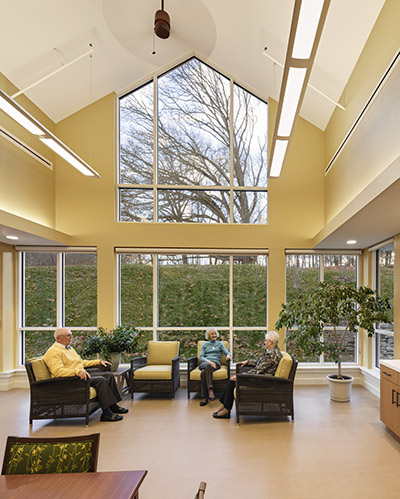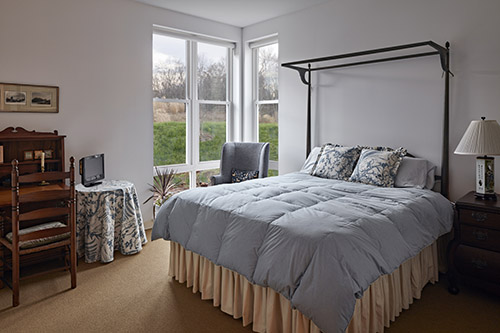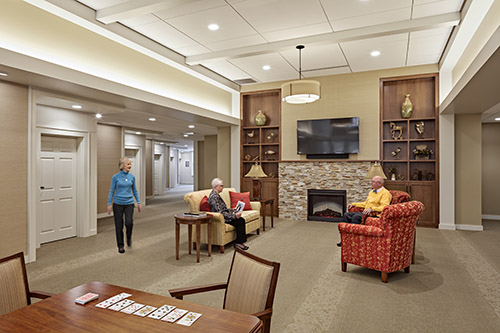By Myles Brown, AIA, LEED AP / Blueprints for Senior Living newsletter, May 2017

A majestic 100-year-old oak organizes a 12-unit addition to Duncaster Retirement Community’s Assisted Living Memory Care Neighborhood in Bloomfield, CT, symbolizing strength, endurance, protection, success and stability to its residents.
The over-arching criterion for the facility was to design for cognitive clarity, simplicity, and way-finding ease to create a homelike environment that would promote health, wellness and safety for residents with dementia.
Site and light
The site, distinguished by elevated earthen barriers along the east and west, pinched available buildable land. However, the “pinch” created an opportunity to strengthen the design concept, providing natural light and a connection with nature. The site offers views of a wooded area to the south, existing landscaped courtyards to the north, and anticipates future development of landscape features in the raised landscape to the east and west.

Interior inspiration
The oak tree, known now to residents as the “Charter Oak,” became an organizing element for the building’s form and placement, and was the inspiration in the interior design’s “Connection to Nature” theme. Residents catch glimpses of the tree from resident rooms and can appreciate its full magnificence from a glassed activity room, or conservatory. The tree often is the subject of paintings or drawings created by residents in Art Therapy Classes, and it is also used by residents to mark seasonal changes.
The Connection to Nature theme, based on research that this promotes health and well-being, is emphasized in the selection of a warm natural palette of materials, colors, textures, patterns, and fixtures. The organic pattern of the earthy green and tan carpet, wood tones selected for millwork, warm grass cloth-textured wallcoverings, soft organic-shaped pendant light fixture shades, and natural patterns in furniture fabrics reinforce the theme.

Small house
The floor plan is based on a “small house concept,” with resident rooms organized around a central space containing a country kitchen, dining room, and living room. Simple features and details, such as the bead board ceiling and column and beam dividers, define the space and reference elements typical of New England homes.

Design aids in memory care
Older adults may experience additional cognitive losses that accompany dementia. These loses can have a dramatic effect on safety and the ability to perform basic daily functions. However, a careful and thoughtful approach to design can help compensate. While this design principle guides all Senior Living spaces, it is exponentially more critical in the design of Memory Care facilities.
Some examples include:
- Subtle color transitions in flooring to prevent confusion and a sense of “visual cliffing” in those with memory and visual impairment.
- Deliberate use of contrasting colors between walls and floors with a white base to help residents distinguish boundaries.
- The maximization of daylighting and views to the outdoors.
- Careful selection of artificial lighting in terms of color rendition, higher than average luminance, and programmable controls to reduce light levels in the evening. This helps regulate residents’ normal circadian rhythms, reduces sundowning, and fulfills a desire for an outdoor connection.
Conceptually, we approach design for memory care like we would any project, with the belief that design can make difference in people’s lives. We are always focused on maximizing natural light and views to the outdoors, while creating well-proportioned, clearly organized, interconnected interior spaces that foster both social interaction and independence. While design for memory care requires a careful attention to detail for the specialized needs of residents with dementia, good design makes these details invisible, enabling us to focus on the beautiful qualities of the space.
* All photos are credited to Robert Benson Photography.
_____________________________
About the author

Myles Brown, AIA, is principal of Amenta Emma Architect’s Senior Living Studio. Current projects include: Thames Edge at Fairview - Odd Fellows Home of CT., Duncaster Retirement Community, Avery Heights and Covenant Village of Cromwell. The Grove at Cromwell Village received an AIA National Design for Aging Review, 13th Edition Award in 2015.